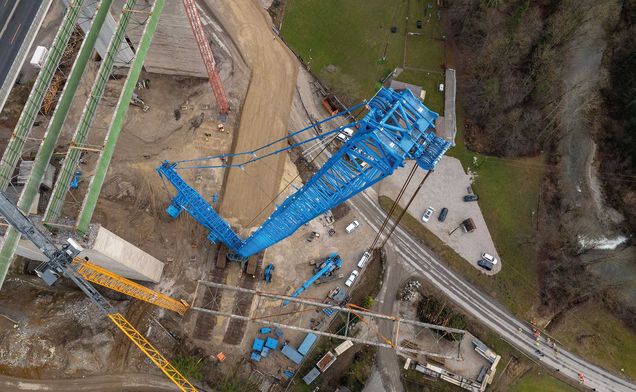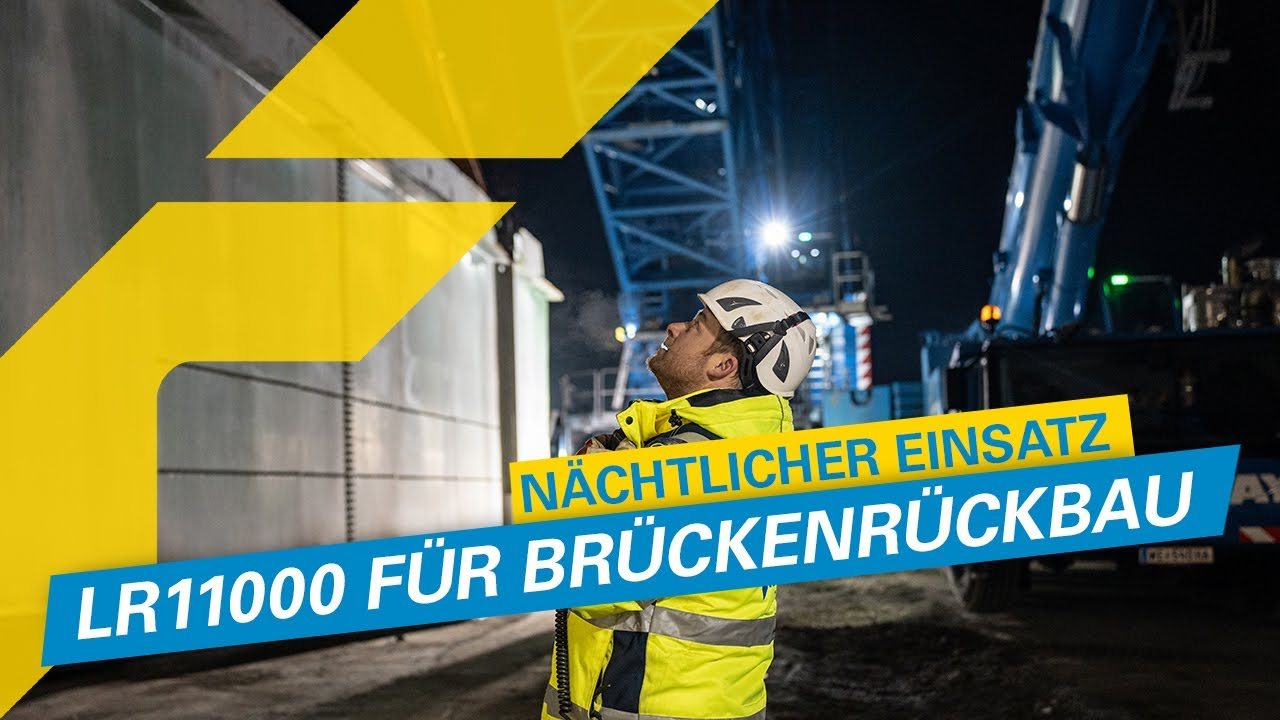Bridge demolition – Crane giant and strand jack system in use
May 19, 2024 | Lucia Reinsprecht
There were already scores of onlookers pulling out their smartphones during its installation on the motorway heading towards Vienna at the beginning of February. The press then got wind of it too: “Major construction work is underway on the West Autobahn near Regau” or “Steel behemoth pushes bridge construction site” were headlines in regional and national media shortly thereafter. He hadn't expected so much fanfare, says Michael Lehner, project manager for transport and lifting technology. However, he could understand the excitement surrounding "Big Blue": “We typically use the LR 11000 in wind farms or in industry. You don't normally get that close to a crane that big”.
The dimensions of the " leading actor" also highlighted its arrival and installation: 50 lorry loads and a scaffolding crane were used to move it to "its stage", Lehner explains further. During the four-day installation period, interested parties and the press picked the best places to watch the first two lifts live alongside the motorway.
Three parking lots
During the deployment period, which lasted around four weeks, spectators had the chance to marvel at “Bug Blue” in its various dimensions at three different locations. This was because it was necessary to change the position and configuration of the crawler crane twice in order to remove the 420-metre-long steel girders that had been towering over the Aurach valley for more than 60 years. In order to lift the first two 70-metre-long and 120-tonne elements, the 1,000-tonne crane was outfitted with a 66-metre-long main boom and 150 tonnes of additional ballast. "The different lengths and weights of the bridge sections and the local conditions meant that there were different requirements at each position, which we handled with the appropriate configuration," explains Lehner. The project preparation therefore not only included technical feasibility, but also a substantial logistical effort. Route permits for the special transports across the motorway had to be obtained in advance and the parking spaces on the motorway and in the valley with limited space had to be prepared. Each time, it took four to five days before the gigantic crane with a tare weight of up to 1,500 tonnes was ready to be lifted to the next position.
In order to tackle the second task in the valley below the Aurach bridge, the Felbermayr team upgraded the main boom to a length of 114 metres. Bridge sections measuring four metres high and 70 metres long and weighing 170 tonnes had to be safely and precisely lowered from the former motorway between the tower cranes. “In order to manoeuvre the necessary rotation between the forest, buildings and cranes, we had to reballast the crane several times during the lift”, explains Jan Kürner, the supervisor responsible for coordinating the crane.
“Engineered Solutions” brings the strand jack into position
It might be hard to believe, but even the LR 11000 has its limits. When a mountain river runs through the site, for example. The fact that the Felbermayr Group can also adapt to such demands is what makes it special, says Michael Lehner: “We work shoulder to shoulder within the group of companies and can therefore draw on a wide range of expertise.” The solution was a call to the specialists in Felbermayr's Engineered Solutions division in Krefeld. Their speciality: Innovative solutions for the heavy industry And once again, they showcased their engineering skills at the highest level – and not just literally: They installed a structure built specifically for this purpose in order to lower the two affected bridge sections, each weighing 180 tonnes and measuring 65 metres in length: A total of four strand jacks, each with a tare weight of one tonne and a height of two metres, were mounted on four girders on each side. The total pulling capacity was 400 tonnes. "The planning time for this project was approximately three months," says Project Manager of Engineered Solutions, Martin van der Pluijm, and continues: “To test the design for the big showdown, we simulated the process ahead of time in our hall using two 420-tonne presses.”
As February drew to a close, it became obvious whether or not the customised solution would also work under the difficult conditions on site. “We had to be driven up in work baskets to carry out the installation at this height. There was also barely enough space on the bridge for twelve square metres of scaffolding," van der Pluijm continues, explaining the challenge of the on-site installation: “First of all, we built the support structure and mounted the strand jacks with the hanging strands on it.” This made it possible for us to place the girders under the bridge section to clamp it in our strand jacks”. Chains were also mounted at the rear to brace the construction to prevent it from tipping forwards. The bridge sections were cut diagonally – tapering upwards – for the ensuing four-hour lowering process so that they would not get stuck.
Showdown at night
There was a spectacular overnight operation marking the conclusion of the project. The Felbermayr Transport and Lifting Technology team encountered their toughest challenge at the third and final station: It had to be ensured that the railway traffic running under the last field was not at risk. They had exactly four hours to complete the job. Every move had to be perfect from 11 pm to 4 am. The two heaviest parts, each weighing in at 240 tonnes and spanning 72 metres, had to be carefully lifted out of their abutments and placed back on the motorway. “To achieve this, we started in the morning”, explains Kürner. They then started the lifting process exactly one hour before midnight. To do this, the crawler crane with its 78 metre long main boom and bridge made a 180 degree turn on the hook.
When the last steel girder was safely set down on the former hard shoulder early on Saturday morning, the job was finally done. Michael Lehner is clearly satisfied: “Ultimately, every lifting operation worked well. The ongoing coordination effort with the customer was excellent at every level - a challenging but enjoyable job at our doorstep, so to speak.”
punctuation.








